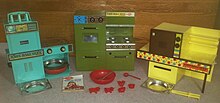
An incandescent light bulb, incandescent lamp or incandescent light globe is an electric light with a filament that is heated until it glows. The filament is enclosed in a glass bulb that is either evacuated or filled with inert gas to protect the filament from oxidation. Electric current is supplied to the filament by terminals or wires embedded in the glass. A bulb socket provides mechanical support and electrical connections.

Grilling is a form of cooking that involves heat applied to the surface of food, commonly from above, below or from the side. Grilling usually involves a significant amount of direct, radiant heat, and tends to be used for cooking meat and vegetables quickly. Food to be grilled is cooked on a grill, using a cast iron/frying pan, or a grill pan.
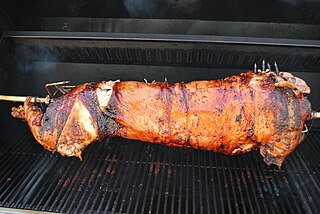
Roasting is a cooking method that uses dry heat where hot air covers the food, cooking it evenly on all sides with temperatures of at least 150 °C (300 °F) from an open flame, oven, or other heat source. Roasting can enhance the flavor through caramelization and Maillard browning on the surface of the food. Roasting uses indirect, diffused heat, and is suitable for slower cooking of meat in a larger, whole piece. Meats and most root and bulb vegetables can be roasted. Any piece of meat, especially red meat, that has been cooked in this fashion is called a roast. Meats and vegetables prepared in this way are described as "roasted", e.g., roasted chicken or roasted squash.

A microwave oven or simply microwave is an electric oven that heats and cooks food by exposing it to electromagnetic radiation in the microwave frequency range. This induces polar molecules in the food to rotate and produce thermal energy in a process known as dielectric heating. Microwave ovens heat foods quickly and efficiently because excitation is fairly uniform in the outer 25–38 mm(1–1.5 inches) of a homogeneous, high-water-content food item.

Hasbro, Inc. is an American multinational conglomerate holding company incorporated and headquartered in Pawtucket, Rhode Island. Hasbro owns the trademarks and products of Kenner, Milton Bradley, Parker Brothers, and Wizards of the Coast, among others. As of August 2020, over 81.5% of its shares were held by large financial institutions.

Cookware and bakeware is food preparation equipment, such as cooking pots, pans, baking sheets etc. used in kitchens. Cookware is used on a stove or range cooktop, while bakeware is used in an oven. Some utensils are considered both cookware and bakeware.

An oven is a tool which is used to expose materials to a hot environment. Ovens contain a hollow chamber and provide a means of heating the chamber in a controlled way. In use since antiquity, they have been used to accomplish a wide variety of tasks requiring controlled heating. Because they are used for a variety of purposes, there are many different types of ovens. These types differ depending on their intended purpose and based upon how they generate heat.
Kenner Products, known simply as Kenner, was an American toy company founded in 1946. Throughout its history, the Kenner brand produced several highly recognizable toys and merchandise lines including action figures like the original series of Star Wars, Jurassic Park and Batman as well as die cast models. The company was closed and merged by its corporate parent Hasbro in 2000.

A kitchen stove, often called simply a stove or a cooker, is a kitchen appliance designed for the purpose of cooking food. Kitchen stoves rely on the application of direct heat for the cooking process and may also contain an oven, used for baking. "Cookstoves" are heated by burning wood or charcoal; "gas stoves" are heated by gas; and "electric stoves" by electricity. A stove with a built-in cooktop is also called a range.

A compact fluorescent lamp (CFL), also called compact fluorescent light, energy-saving light and compact fluorescent tube, is a fluorescent lamp designed to replace an incandescent light bulb; some types fit into light fixtures designed for incandescent bulbs. The lamps use a tube that is curved or folded to fit into the space of an incandescent bulb, and a compact electronic ballast in the base of the lamp.
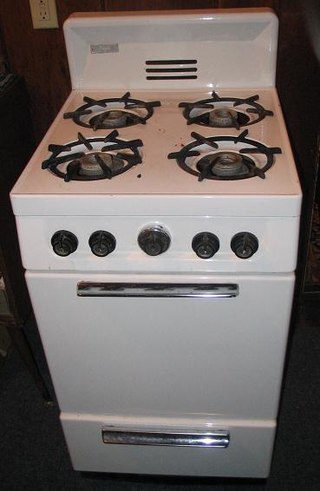
A gas stove is a stove that is fuelled by combustible gas such as natural gas, propane, butane, liquefied petroleum gas, syngas, or other flammable gas. Before the advent of gas, cooking stoves relied on solid fuels such as coal or wood. The first gas stoves were developed in the 1820s and a gas stove factory was established in England in 1836. This new cooking technology had the advantage of being easily adjustable and could be turned off when not in use. The gas stove, however, did not become a commercial success until the 1880s, by which time supplies of piped gas were available in cities and large towns in Britain. The stoves became widespread on the European Continent and in the United States in the early 20th century.

The Coleman Company, Inc. is an American brand of outdoor recreation products, especially camping gear, now owned by Newell Brands. The company's new headquarters are in Chicago, and it has facilities in Wichita, Kansas, and in Texas. There are approximately 4,000 employees. Some of the products manufactured are portable stoves, lanterns, coolers, sleeping bags, camp chairs, and shelters.

A cooktop, stovetop or hob, is a device commonly used for cooking that is commonly found in kitchens and used to apply heat to the base of pans or pots. Cooktops are often found integrated with an oven into a kitchen stove but may also be standalone devices. Cooktops are commonly powered by gas or electricity, though oil or other fuels are sometimes used.

A masonry heater is a device for warming an interior space through radiant heating, by capturing the heat from periodic burning of fuel, and then radiating the heat at a fairly constant temperature for a long period. Masonry heaters covered in tile are called cocklestoves. The technology has existed in different forms, from back into the Neoglacial and Neolithic periods. Archaeological digs have revealed excavations of ancient inhabitants utilizing hot smoke from fires in their subterranean dwellings, to radiate into the living spaces. These early forms have evolved into modern systems.

Irwin Toy Limited was a Canadian distributor and manufacturer of toys. It was Canada's oldest toy company and remained independent and family owned until 2001.
Infrared lamps are electrical devices which emit infrared radiation. Infrared lamps are commonly used in radiant heating for industrial processes and building heating. Infrared LEDs are used for communication over optical fibers and in remote control devices. Infrared lamps are also used for some night vision devices where visible light would be objectionable. Infrared lamp sources are used in certain scientific and industrial instrument for chemical analysis of liquids and gases; for example, the pollutant sulfur dioxide in air can be measured using its infrared absorption characteristics.
Ronald B. Howes was an American toy inventor, best known for his invention of the Easy-Bake Oven, which was introduced to consumers in 1963.
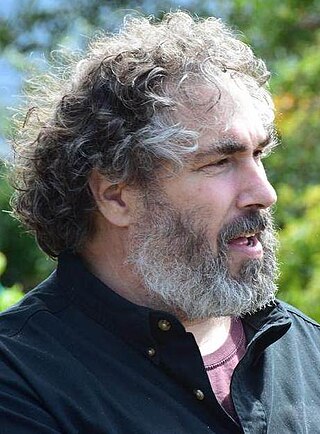
Paul Wheaton is an American permaculture author, master gardener, software engineer, and disciple of the natural agriculturist Sepp Holzer. He is known for writing his book, "Building a Better World in Your Backyard", founding Permies, the largest website devoted to permaculture, as well as for creating and publishing articles, videos, and podcasts on the subject of permaculture.
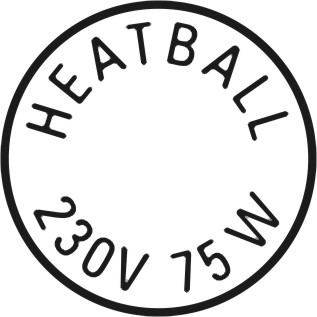
Heatball is a brand name for an incandescent lamp. The brand was used as part of a scheme by Siegfried Rotthäuser, a mechanical engineer from Essen in Germany, to stimulate discussion of EU Regulation 244/2009. This Regulation forbade the importation or sale of light sources with energy efficiency worse than 'Class C' after September 2012 as part of the phase-out of incandescent light bulbs.
The Queasy Bake Cookerator was a variant of the Easy-Bake Oven working toy oven, produced by Hasbro in 2002. It was discontinued soon afterwards. The toy used a standard 100-watt incandescent light bulb as a heat source, and had a warming chamber on top of the oven. While the Easy-Bake Oven is traditionally marketed towards girls, the Queasy Bake Cookerator represented Hasbro's attempt to branch into the male demographic by appealing to "boys' affinity for all things gross".
